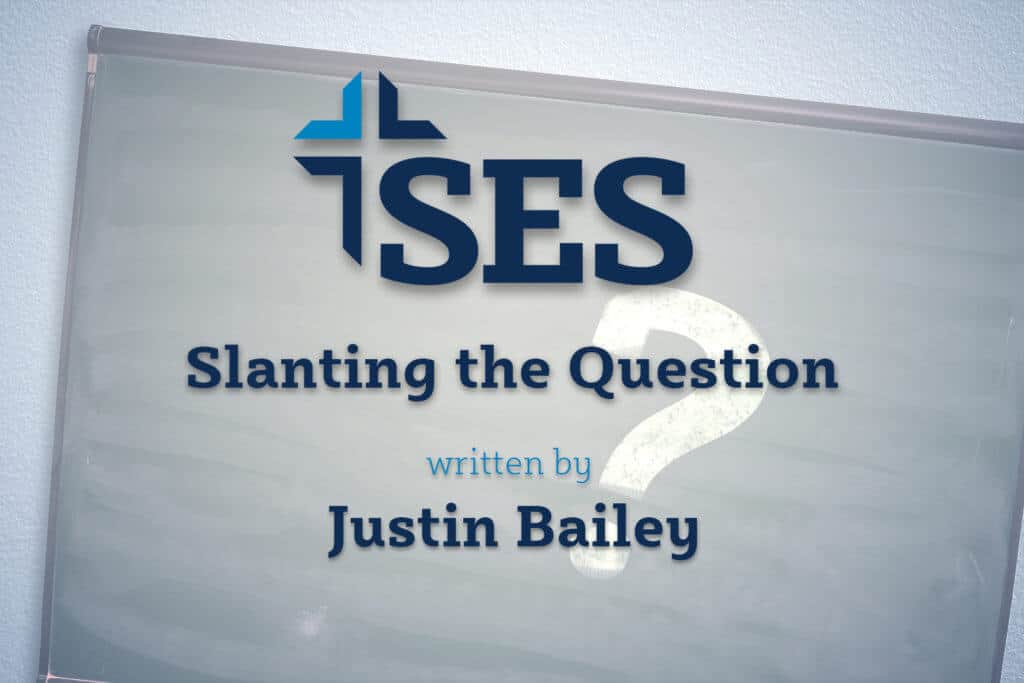[et_pb_section bb_built=”1″][et_pb_row][et_pb_column type=”4_4″][et_pb_text _builder_version=”3.0.67″ background_layout=”light” text_orientation=”left” border_style=”solid”]
“Don’t you want me to have a treat that’s good for my bones!?” responded my 9-year-old son after I questioned him about the heaping bowl of ice cream he just served himself. My wife and I recently made a point of encouraging good nutrition, but my son’s incredulous response revealed he had taken some liberty with our instruction. But doesn’t ice cream contain calcium, which is widely held to contribute to bone health? It does. But this isn’t the whole story, is it? Ice cream also contains sugar and dairy: ingredients to which he is acutely sensitive.
My son’s response was a case of slanting the question. Peter Kreeft categorizes this fallacy as inductive because it moves from the particular to the general.¹ For example, moving from this particular bowl of ice cream to the general principle that anything that can be argued to promote healthy, strong bones should get a green light. Further, in this fallacy a question is “asked with a predisposed idea. In other words, the way the question is worded may be subjective.”²
In his work, Truth And Method, Hans-Georg Gadamer examines the importance of the question in attaining knowledge, noting on a fundamental level, “The word ‘slanted’ refers to something that has deviated from the right direction.”³ This misdirection is crucially important to recognize because it leads us away from a knowledge of the truth. Gadamer observes,
There can be no answer to slanted question because it leads us only apparently, and not really, through the open state of indeterminacy in which a decision is made. We call it slanted rather than wrongly put because there is a question behind it—i.e., there is an openness intended, but it does not lie in the direction in which the slanted question is pointing.⁴
Thus the one posing a slanted question is behaving, perhaps unintentionally, in an intellectually dishonest manner by framing his position in the form of a question, presenting himself as open-minded when his mind is already made up.
This is apparent when we return to the 9-year-old. Was my dear little rule-bender truly seeking an answer? Don’t bet on it. His question only feigned openness to correction while his actions revealed he had already made the decision that his question now served. According to Gadamer, my son’s apparent openness did not lie in the direction his slanted question was pointing. In other words, he was closed to my wife’s and my upholding our previous decision to impose limits on his diet and open only to eating that bowl of ice cream.
As we can see, this leaves the one to whom the question is posed in a tough spot. Gadamer continues,
The slant of a question consists in the fact that it does not give any real direction, and hence no answer to it is possible. Similarly we say that statements which are not exactly wrong but also not right are ‘slanted.’ This too is determined by their sense—i.e., by their relation to the question. We cannot call them wrong, since we detect something true about them, but neither can we properly call them right because they do not correspond to any meaningful question and hence have no correct meaning unless they are themselves corrected.⁵
Thus, the one on the receiving end of a slanted question rightly feels manipulated because the question already assumes its answer. In a court of law, these types of questions are ripe for objection precisely because they have the potential to steer witness testimony. In more stark terms they are an attempt to illicitly influence by either omitting pertinent information or introducing irrelevant information as a smoke screen. Case in point: my son sought to draw my attention to the relative merits of his calcium-rich dessert choice rather than the demerits of its sugar and dairy content.⁶
Logical sleight-of-hand moves like these are not always obvious, but as Gadamer notes, often involve a fair amount of truth. How then do we know when we’re presented with a slanted question? What follows is a short list of possible “tells.” It is by no means exhaustive, but should get us thinking about some ways to recognize this logical fallacy. In each of these areas, one can see how the slanted question in complete transparency doesn’t represent a question at all, but a veiled attempt to feign openness as a trojan horse to influence.
Polarizing: By its very definition slanting the question heavily—if not entirely—polarizes the discussion with the intent to sway one’s interlocutor. As a result, if the question only points to one answer, this compromises the intellectually integrity of the discussion and should raise our suspicions.⁷
Flattering: My son’s glowing report of his calcium rich, albeit sugar-laden treat praised the somewhat dubious benefits of ice cream to the exclusion of its potential negative impact on his health.
Demonizing: Conversely my son and I may have had a conversation earlier that evening about the utter worthlessness of broccoli. While few would dispute the superiority of ice cream in flavor and texture, I’m convinced even fewer would maintain it’s higher nutritional value. The two conversations taken together make an illicit case for more delicious but inferior nutrition.
Over-simplifying: A failure to grasp the complexity of a given issue can lead one to misrepresent it entirely. As we noted earlier, while ice cream is a calcium-rich treat, it also contains other ingredients that are far less desirable for my son.
Over-complicating: Conversely the use of over-complication seeks to bury the hearer in (perhaps true) but irrelevant details.
By now the importance of recognizing a slanted question should be obvious. However, a proper identification can help us peel back the facade and identify deficiencies in our or another’s position and reveal the need for more careful thought and/or thorough study. Again, what follows is an abbreviated list but sufficient to illustrate the types of issues that can potentially fuel a slanted question. While these can also be broadly classified as “tells,” they are also frequently drivers of logical fallacy.
Insufficient information: Recognizing the use of this logical fallacy can help us determine that we need more information in order to assess the merit of another’s argument or even our own. If I was unaware of the ingredients of ice cream, I would be hard-pressed to challenge my son’s assertion of its health benefits.
Bias: Properly identifying a slanted question can make us aware of bias in ourselves as well as less susceptible to influence of the bias of others.
Agenda: It is no news that we all have opinions—some of which we properly and strongly hold. However, our opinions should always be subject to truth. Frequently individuals have a soap box or an axe to grind, leading them to overlook facts that weaken their position. My son’s desire for ice cream fueled his agenda, putting him at odds with the truth that his choice would ultimately negatively affect him.
Needless to say it’s important to guard against being taken in by slanted questions or falling into the trap of using them ourselves. As mentioned earlier they can feel manipulative because they are. Slanting the question is deceptive, and apart from not serving the pursuit of truth and knowledge, completely fails to treat others with intellectual honesty, something to which the follower of Jesus Christ should be keenly sensitive.
If we desire to attain true knowledge and accurately represent reality, we must think, speak and act in a logically consistent, disciplined and accountable manner. In doing so our thoughts, words, and actions more accurately represent our Creator and keep us intellectually above reproach in our witness to others.
[/et_pb_text][et_pb_divider _builder_version=”3.0.67″ show_divider=”on” color=”#0083ca” divider_style=”solid” divider_position=”top” divider_weight=”5″ hide_on_mobile=”on” saved_tabs=”all” /][et_pb_text _builder_version=”3.0.67″ background_layout=”light” text_orientation=”left” border_style=”solid”]
- Peter Kreeft, Socratic Logic (South Bend, IN: St. Augustine’s Press, 2010), 104.
- Maria Constandinou, Survey and Report, Slanted Question, accessed 7/20/17, http://www.recitfga.qc.ca/english/2010activities/mariaconstandinou/TXT/Slanted_question.pdf.
- Hans-Georg Gadamer, Truth And Method (New York, NY: Bloomsbury Academic, 2004), 372.
- Ibid., 372.
- Gadamer, 372.
- Also worthy of note is the fact that slanting the question differs from the logical fallacy of “slant” most obviously in that the former is a question instead of a statement. However, the greater significance is that the question foists the burden of a response on the recipient, one in which the answer is either predetermined or doesn’t exist at all.
- An obvious exception is a rhetorical question that assumes an answer; however, this is most frequently employed as a rhetorical device in order to make a point clear, not obscure it.
[/et_pb_text][/et_pb_column][/et_pb_row][/et_pb_section]






